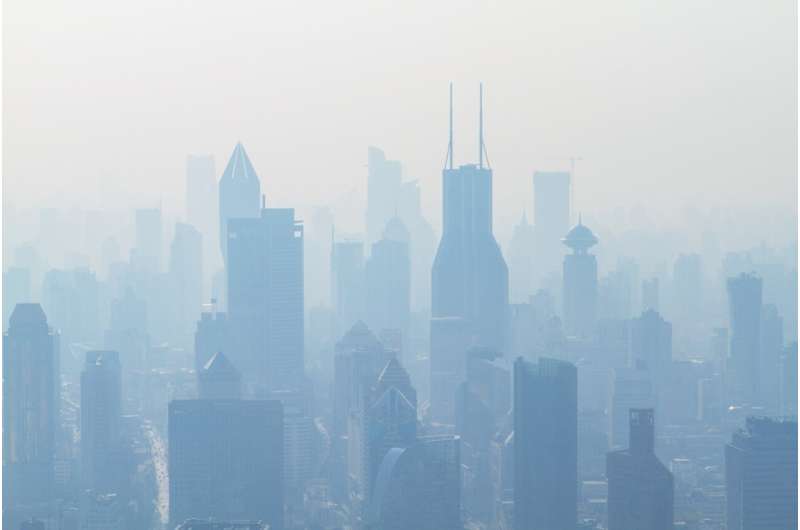Air pollution can amplify negative effects of climate change, new study finds

The impacts of air pollution on human health, economies, and agriculture differ drastically depending on where on the planet the pollutants are emitted, according to a new study that could potentially incentivize certain countries to cut climate-changing emissions.
Led by the University of Texas at Austin and the University of California San Diego, the study, which was published Sept. 23 in Science Advances, is the first to simulate how aerosol pollution affects both climate and air quality for locations around the globe.
Aerosols are tiny solid particles and liquid droplets that contribute to smog and are emitted from industrial factories, power plants and vehicle tailpipes. They impact human health, agricultural and economic productivity in unique global patterns when compared with carbon dioxide (CO2) emissions, which are the focus of efforts to mitigate climate change.
Although CO2 and aerosols are often emitted at the same time during the combustion of fuel, the two substances behave differently in Earth's atmosphere, said co-lead author Geeta Persad, an assistant professor at the UT Austin Jackson School of Geosciences.
"Carbon dioxide has the same impact on climate no matter who emits it," said Persad. "But for these aerosol pollutants, they tend to stay concentrated near where they're emitted, so the effect that they have on the climate system is very patchy and very dependent on where they're coming from."
The researchers found that, depending on where they are emitted, aerosols can worsen the social costs of carbon—an estimate of the economic costs greenhouse gasses have on society—by as much as 66%. The scientists looked at eight key regions: Brazil, China, East Africa, Western Europe, India, Indonesia, United States and South Africa.
"This research highlights how the harmful effects of our emissions are generally underestimated," said Jennifer Burney, co-lead author and the Marshall Saunders Chancellor's Endowed Chair in Global Climate Policy and Research at the UC San Diego School of Global Policy and Strategy. "CO2 is making the planet warmer, but it also gets emitted with a bunch of other compounds that impact people and plants directly and cause climate changes in their own right."
The work, which was supported by the National Science Foundation, represents a collaboration between Persad and Burney, who are physical scientists, and a group of economists and public health experts. Co-authors include Marshall Burke, Eran Bendavid, and Sam Heft-Neal at Stanford University and Jonathan Proctor at Harvard University.
Aerosols can directly affect human health and the climate independently of CO2. They are associated with negative health impacts when inhaled, and can affect the climate by influencing temperature, precipitation patterns and how much sunlight reaches the Earth's surface.
To study aerosols' influence in comparison to CO2, the team created a set of climate simulations using the Community Earth System Model version 1 developed by the National Center for Atmospheric Research. They ran simulations in which each of the eight regions produced identical aerosol emissions and mapped how temperature, precipitation, and surface air quality were affected across the globe. Then they connected this data with known relationships between climate and air quality and infant mortality, crop productivity, and gross domestic product across the eight regions.
In a final step, they compared the total societal costs of these aerosol-driven impacts against the societal costs of co-emitted CO2 in each of the eight regions, and produced global maps of the combined effects of aerosols and CO2. The researchers said the study is a big step forward from previous work, which either only estimated the air quality impacts of aerosols or didn't consider their diverse global climate effects.
The outcome paints a varied and complicated picture. Emissions from some regions produce climate and air quality effects that range from two to more than 10 times as strong as others and social costs that sometimes affect neighboring regions more than the region that produced the aerosol emissions. For example, in Europe local emissions result in four times as many infant deaths outside Europe as within.
But the researchers note that aerosol emissions are always bad for both the emitter and the planet overall.
"While we might think about aerosols, which cool the climate, as having the silver lining of counteracting CO2-driven warming, when we look at all these effects in combination, we find that no region experiences overall local benefits or generates overall global benefits by emitting aerosols," said Persad.
Researchers also said the findings create potentially new motivations for countries to cut emissions—and to care about other countries cutting emissions. For example, the study found that adding aerosol costs to CO2 costs could double China's incentive to mitigate emissions. And it switches the impact of local emissions in Europe from a net local benefit to a net cost. The study also shows that some emerging economies, like East African nations and India, might be motivated to collaborate on emission cuts since they are strongly impacted by each other's emissions.
The framework developed in this study can also be applied to maximize societal benefits from current mitigation strategies being considered by policy makers. For example, the researchers applied it to the "fair-share" approach laid out in the Paris Climate Agreement in which all countries target the same per-capita CO2 emissions. They found the approach, while beneficial for climate stability, does not improve the mortality and crop impacts from combined aerosol and CO2 emissions because it focuses mitigation in regions that already have fairly low aerosol impacts, like the U.S. and Europe.
"By expanding societal cost calculations to include the geographically-resolved societal impacts of co-emitted aerosols, we're showing that the incentive for individual countries to mitigate and collaborate on mitigation is much higher than if we only think about greenhouse gases," Burney said.
More information: Jennifer Burney et al, Geographically resolved social cost of anthropogenic emissions accounting for both direct and climate-mediated effects, Science Advances (2022). DOI: 10.1126/sciadv.abn7307. www.science.org/doi/10.1126/sciadv.abn7307
Journal information: Science Advances
Provided by University of Texas at Austin





















